BULAW5911 - Case Study: Risk Management Strategies in Business Law
VerifiedAdded on 2022/12/30
|8
|1466
|21
Report
AI Summary
This report delves into the intricacies of business law and risk management, utilizing case studies to illustrate key concepts. The analysis begins with an examination of the Volkswagen emissions scandal, exploring the motivations behind the company's actions, the failures in corporate governance, and the resulting legal and financial repercussions. The report then transitions to an analysis of the Corporations Act in Australia, highlighting its impact on organizational operations and the legal risks faced by managers, directors, and stakeholders. The report further explores legal risk management, compliance, and governance, outlining the tools and principles used by legal departments. It also incorporates an annotated bibliography of relevant sources and a comprehensive bibliography. The report also examines legal aspects of risk management in Australia and the evolution of risk management standards, providing valuable insights for students and professionals alike.
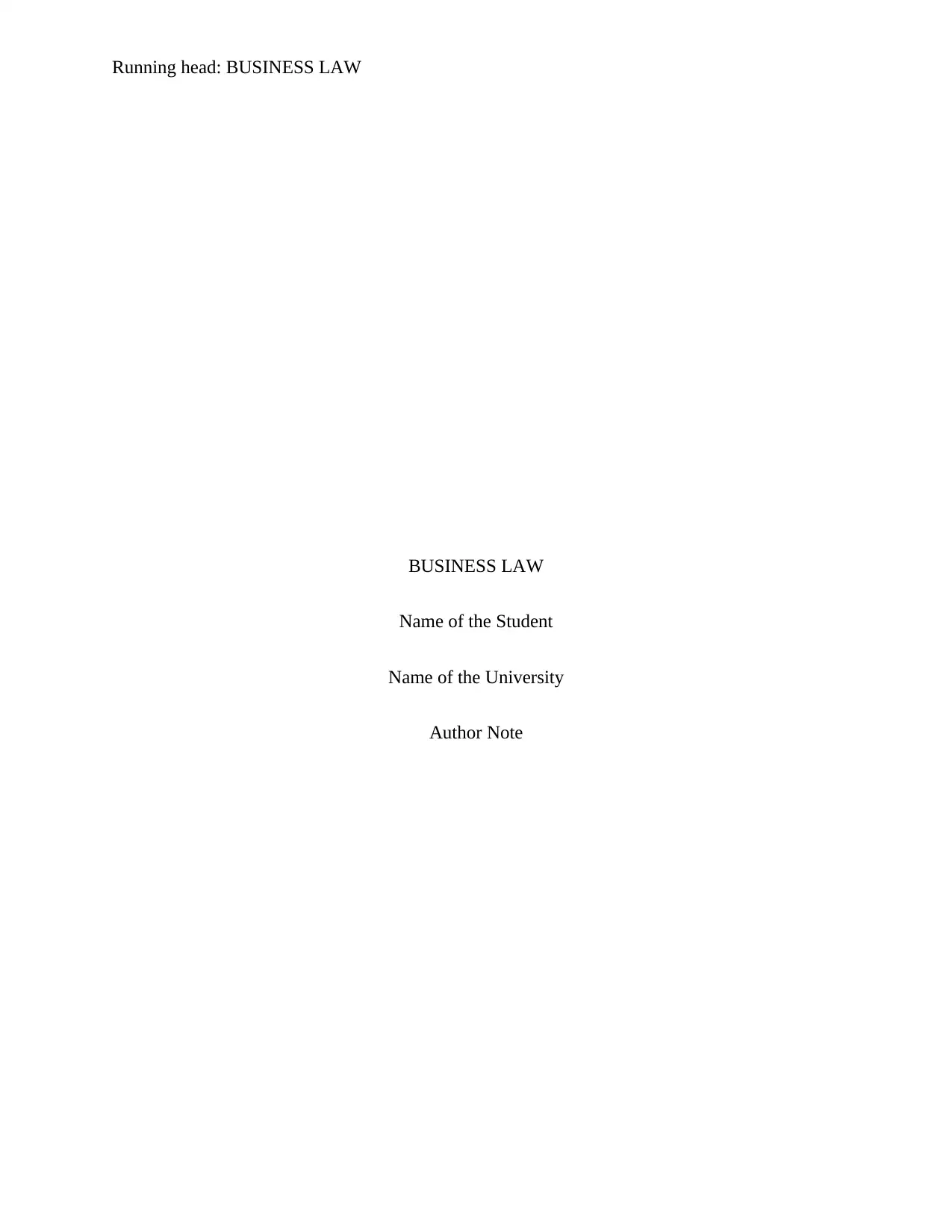
Running head: BUSINESS LAW
BUSINESS LAW
Name of the Student
Name of the University
Author Note
BUSINESS LAW
Name of the Student
Name of the University
Author Note
Paraphrase This Document
Need a fresh take? Get an instant paraphrase of this document with our AI Paraphraser
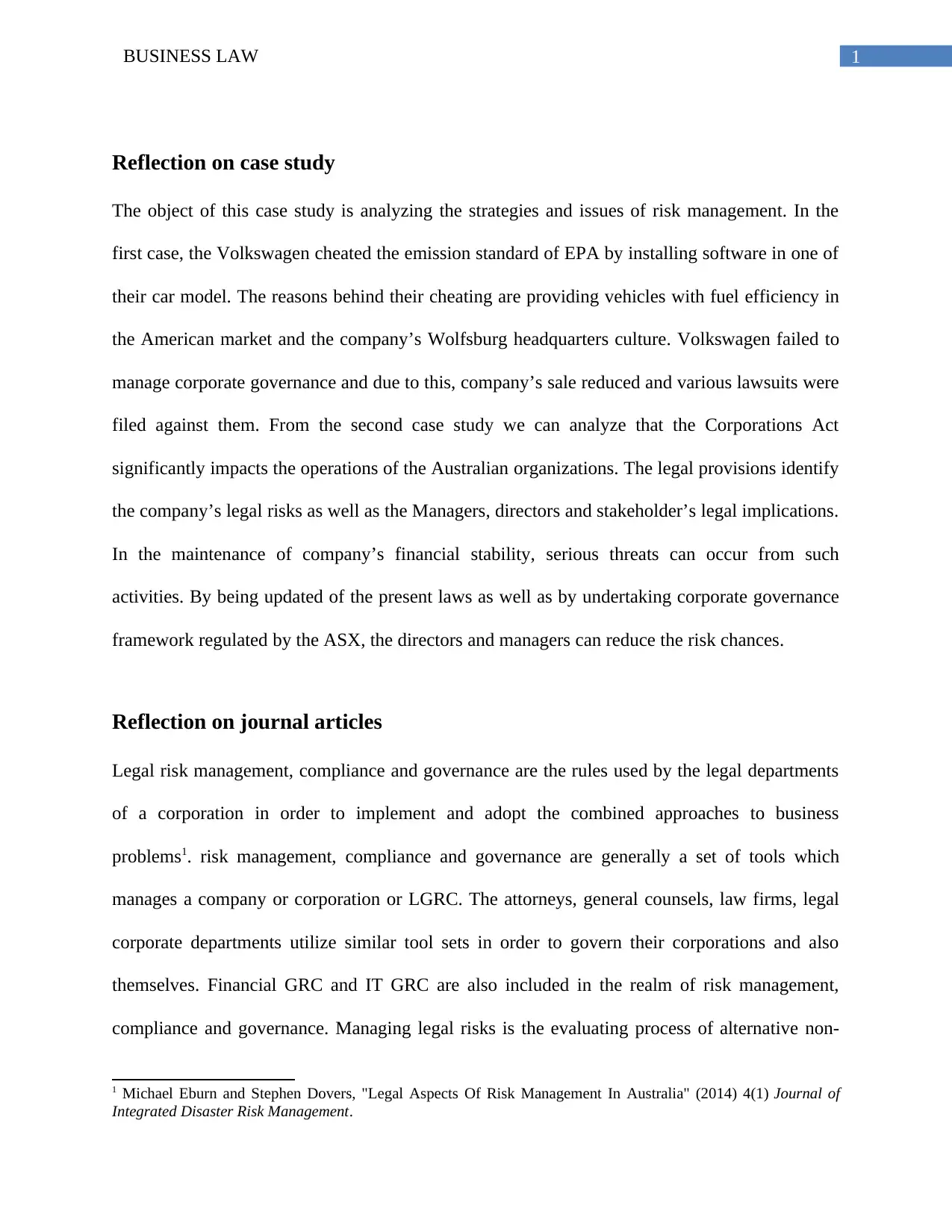
1BUSINESS LAW
Reflection on case study
The object of this case study is analyzing the strategies and issues of risk management. In the
first case, the Volkswagen cheated the emission standard of EPA by installing software in one of
their car model. The reasons behind their cheating are providing vehicles with fuel efficiency in
the American market and the company’s Wolfsburg headquarters culture. Volkswagen failed to
manage corporate governance and due to this, company’s sale reduced and various lawsuits were
filed against them. From the second case study we can analyze that the Corporations Act
significantly impacts the operations of the Australian organizations. The legal provisions identify
the company’s legal risks as well as the Managers, directors and stakeholder’s legal implications.
In the maintenance of company’s financial stability, serious threats can occur from such
activities. By being updated of the present laws as well as by undertaking corporate governance
framework regulated by the ASX, the directors and managers can reduce the risk chances.
Reflection on journal articles
Legal risk management, compliance and governance are the rules used by the legal departments
of a corporation in order to implement and adopt the combined approaches to business
problems1. risk management, compliance and governance are generally a set of tools which
manages a company or corporation or LGRC. The attorneys, general counsels, law firms, legal
corporate departments utilize similar tool sets in order to govern their corporations and also
themselves. Financial GRC and IT GRC are also included in the realm of risk management,
compliance and governance. Managing legal risks is the evaluating process of alternative non-
1 Michael Eburn and Stephen Dovers, "Legal Aspects Of Risk Management In Australia" (2014) 4(1) Journal of
Integrated Disaster Risk Management.
Reflection on case study
The object of this case study is analyzing the strategies and issues of risk management. In the
first case, the Volkswagen cheated the emission standard of EPA by installing software in one of
their car model. The reasons behind their cheating are providing vehicles with fuel efficiency in
the American market and the company’s Wolfsburg headquarters culture. Volkswagen failed to
manage corporate governance and due to this, company’s sale reduced and various lawsuits were
filed against them. From the second case study we can analyze that the Corporations Act
significantly impacts the operations of the Australian organizations. The legal provisions identify
the company’s legal risks as well as the Managers, directors and stakeholder’s legal implications.
In the maintenance of company’s financial stability, serious threats can occur from such
activities. By being updated of the present laws as well as by undertaking corporate governance
framework regulated by the ASX, the directors and managers can reduce the risk chances.
Reflection on journal articles
Legal risk management, compliance and governance are the rules used by the legal departments
of a corporation in order to implement and adopt the combined approaches to business
problems1. risk management, compliance and governance are generally a set of tools which
manages a company or corporation or LGRC. The attorneys, general counsels, law firms, legal
corporate departments utilize similar tool sets in order to govern their corporations and also
themselves. Financial GRC and IT GRC are also included in the realm of risk management,
compliance and governance. Managing legal risks is the evaluating process of alternative non-
1 Michael Eburn and Stephen Dovers, "Legal Aspects Of Risk Management In Australia" (2014) 4(1) Journal of
Integrated Disaster Risk Management.
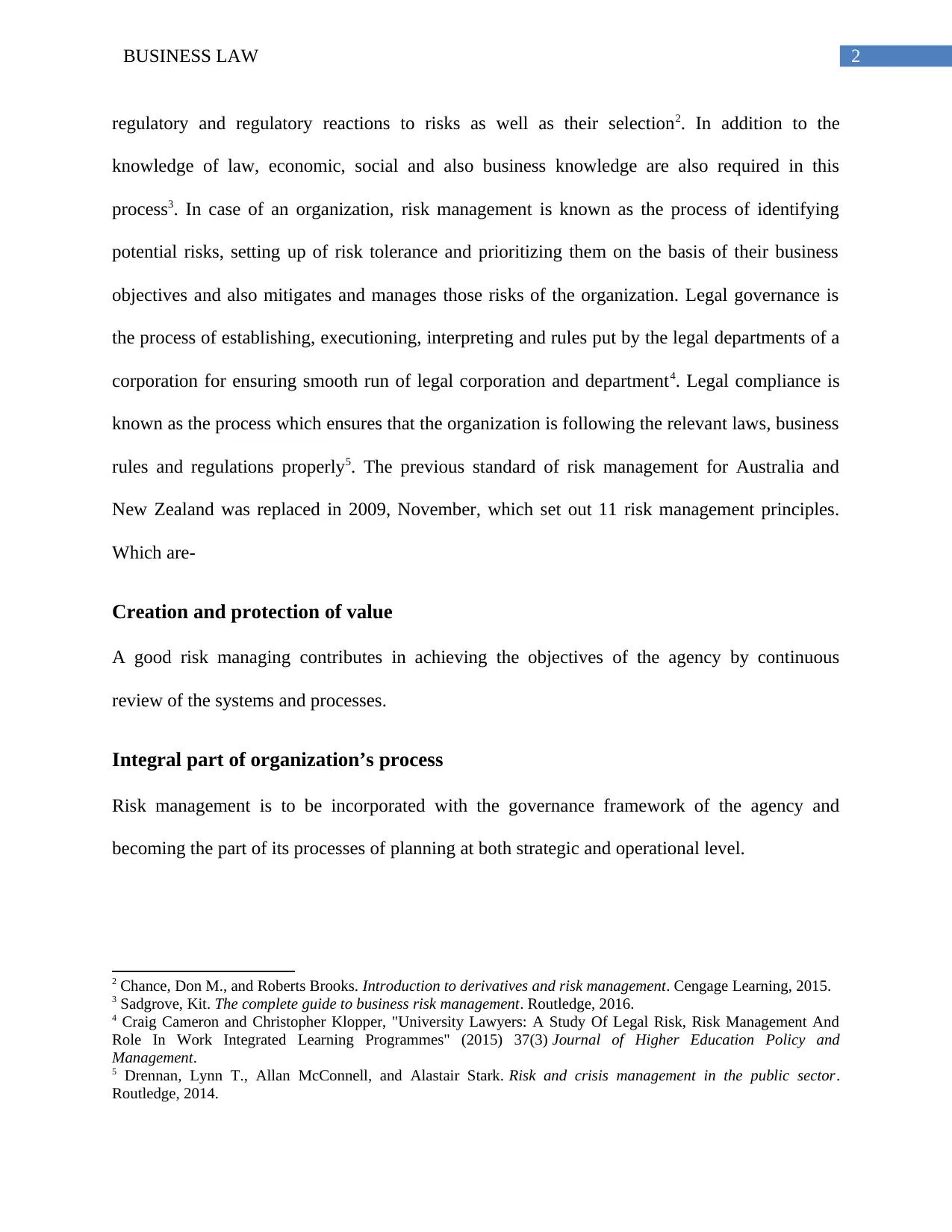
2BUSINESS LAW
regulatory and regulatory reactions to risks as well as their selection2. In addition to the
knowledge of law, economic, social and also business knowledge are also required in this
process3. In case of an organization, risk management is known as the process of identifying
potential risks, setting up of risk tolerance and prioritizing them on the basis of their business
objectives and also mitigates and manages those risks of the organization. Legal governance is
the process of establishing, executioning, interpreting and rules put by the legal departments of a
corporation for ensuring smooth run of legal corporation and department4. Legal compliance is
known as the process which ensures that the organization is following the relevant laws, business
rules and regulations properly5. The previous standard of risk management for Australia and
New Zealand was replaced in 2009, November, which set out 11 risk management principles.
Which are-
Creation and protection of value
A good risk managing contributes in achieving the objectives of the agency by continuous
review of the systems and processes.
Integral part of organization’s process
Risk management is to be incorporated with the governance framework of the agency and
becoming the part of its processes of planning at both strategic and operational level.
2 Chance, Don M., and Roberts Brooks. Introduction to derivatives and risk management. Cengage Learning, 2015.
3 Sadgrove, Kit. The complete guide to business risk management. Routledge, 2016.
4 Craig Cameron and Christopher Klopper, "University Lawyers: A Study Of Legal Risk, Risk Management And
Role In Work Integrated Learning Programmes" (2015) 37(3) Journal of Higher Education Policy and
Management.
5 Drennan, Lynn T., Allan McConnell, and Alastair Stark. Risk and crisis management in the public sector.
Routledge, 2014.
regulatory and regulatory reactions to risks as well as their selection2. In addition to the
knowledge of law, economic, social and also business knowledge are also required in this
process3. In case of an organization, risk management is known as the process of identifying
potential risks, setting up of risk tolerance and prioritizing them on the basis of their business
objectives and also mitigates and manages those risks of the organization. Legal governance is
the process of establishing, executioning, interpreting and rules put by the legal departments of a
corporation for ensuring smooth run of legal corporation and department4. Legal compliance is
known as the process which ensures that the organization is following the relevant laws, business
rules and regulations properly5. The previous standard of risk management for Australia and
New Zealand was replaced in 2009, November, which set out 11 risk management principles.
Which are-
Creation and protection of value
A good risk managing contributes in achieving the objectives of the agency by continuous
review of the systems and processes.
Integral part of organization’s process
Risk management is to be incorporated with the governance framework of the agency and
becoming the part of its processes of planning at both strategic and operational level.
2 Chance, Don M., and Roberts Brooks. Introduction to derivatives and risk management. Cengage Learning, 2015.
3 Sadgrove, Kit. The complete guide to business risk management. Routledge, 2016.
4 Craig Cameron and Christopher Klopper, "University Lawyers: A Study Of Legal Risk, Risk Management And
Role In Work Integrated Learning Programmes" (2015) 37(3) Journal of Higher Education Policy and
Management.
5 Drennan, Lynn T., Allan McConnell, and Alastair Stark. Risk and crisis management in the public sector.
Routledge, 2014.
⊘ This is a preview!⊘
Do you want full access?
Subscribe today to unlock all pages.

Trusted by 1+ million students worldwide
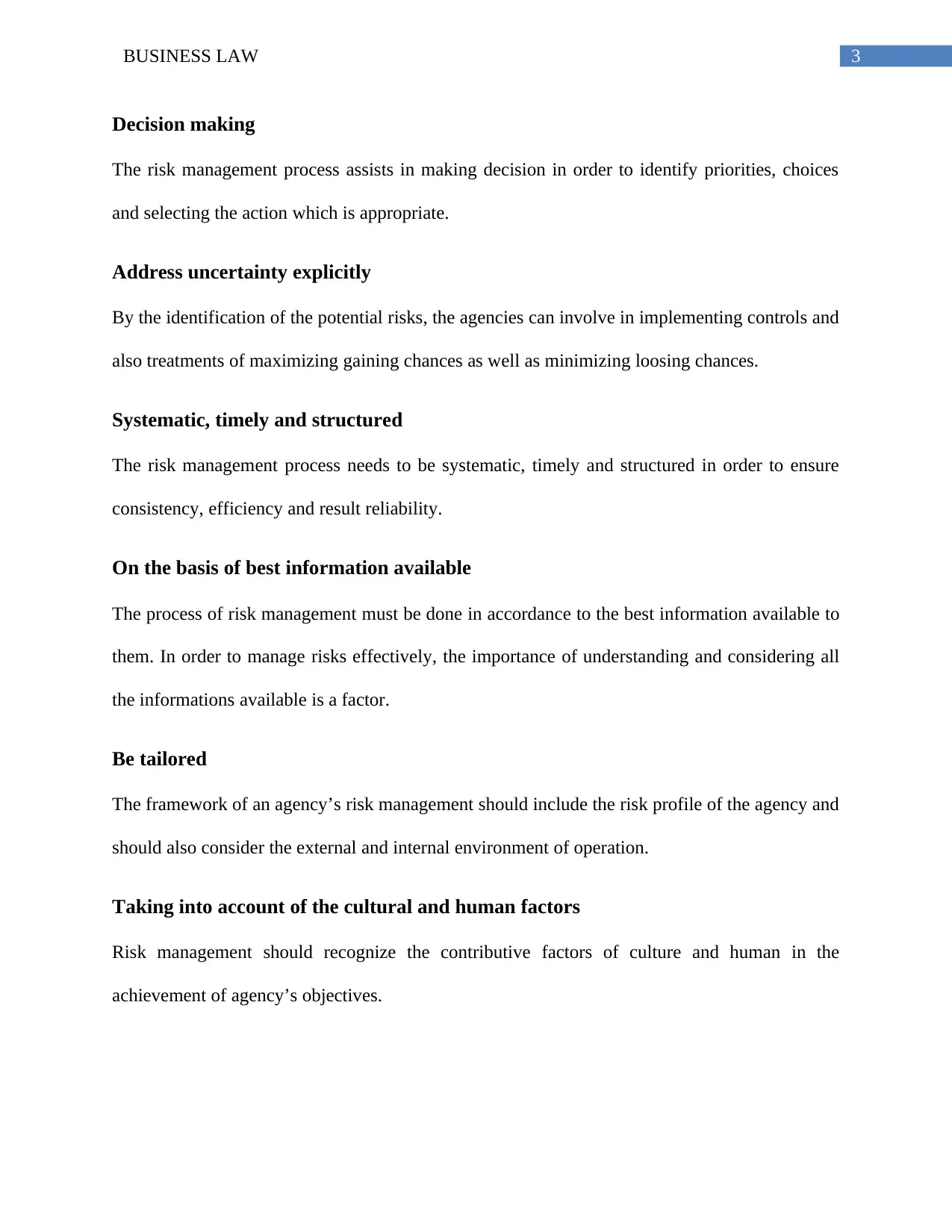
3BUSINESS LAW
Decision making
The risk management process assists in making decision in order to identify priorities, choices
and selecting the action which is appropriate.
Address uncertainty explicitly
By the identification of the potential risks, the agencies can involve in implementing controls and
also treatments of maximizing gaining chances as well as minimizing loosing chances.
Systematic, timely and structured
The risk management process needs to be systematic, timely and structured in order to ensure
consistency, efficiency and result reliability.
On the basis of best information available
The process of risk management must be done in accordance to the best information available to
them. In order to manage risks effectively, the importance of understanding and considering all
the informations available is a factor.
Be tailored
The framework of an agency’s risk management should include the risk profile of the agency and
should also consider the external and internal environment of operation.
Taking into account of the cultural and human factors
Risk management should recognize the contributive factors of culture and human in the
achievement of agency’s objectives.
Decision making
The risk management process assists in making decision in order to identify priorities, choices
and selecting the action which is appropriate.
Address uncertainty explicitly
By the identification of the potential risks, the agencies can involve in implementing controls and
also treatments of maximizing gaining chances as well as minimizing loosing chances.
Systematic, timely and structured
The risk management process needs to be systematic, timely and structured in order to ensure
consistency, efficiency and result reliability.
On the basis of best information available
The process of risk management must be done in accordance to the best information available to
them. In order to manage risks effectively, the importance of understanding and considering all
the informations available is a factor.
Be tailored
The framework of an agency’s risk management should include the risk profile of the agency and
should also consider the external and internal environment of operation.
Taking into account of the cultural and human factors
Risk management should recognize the contributive factors of culture and human in the
achievement of agency’s objectives.
Paraphrase This Document
Need a fresh take? Get an instant paraphrase of this document with our AI Paraphraser
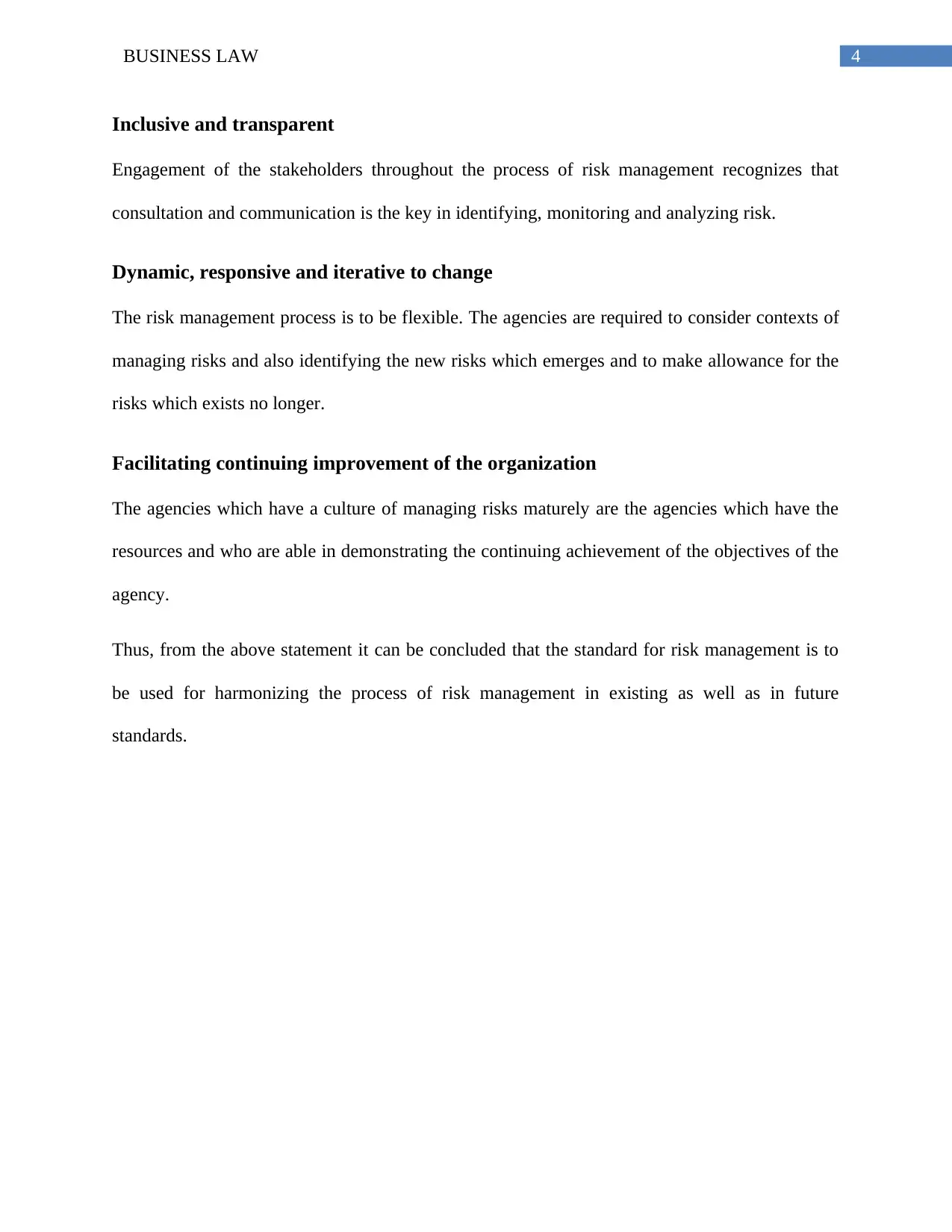
4BUSINESS LAW
Inclusive and transparent
Engagement of the stakeholders throughout the process of risk management recognizes that
consultation and communication is the key in identifying, monitoring and analyzing risk.
Dynamic, responsive and iterative to change
The risk management process is to be flexible. The agencies are required to consider contexts of
managing risks and also identifying the new risks which emerges and to make allowance for the
risks which exists no longer.
Facilitating continuing improvement of the organization
The agencies which have a culture of managing risks maturely are the agencies which have the
resources and who are able in demonstrating the continuing achievement of the objectives of the
agency.
Thus, from the above statement it can be concluded that the standard for risk management is to
be used for harmonizing the process of risk management in existing as well as in future
standards.
Inclusive and transparent
Engagement of the stakeholders throughout the process of risk management recognizes that
consultation and communication is the key in identifying, monitoring and analyzing risk.
Dynamic, responsive and iterative to change
The risk management process is to be flexible. The agencies are required to consider contexts of
managing risks and also identifying the new risks which emerges and to make allowance for the
risks which exists no longer.
Facilitating continuing improvement of the organization
The agencies which have a culture of managing risks maturely are the agencies which have the
resources and who are able in demonstrating the continuing achievement of the objectives of the
agency.
Thus, from the above statement it can be concluded that the standard for risk management is to
be used for harmonizing the process of risk management in existing as well as in future
standards.
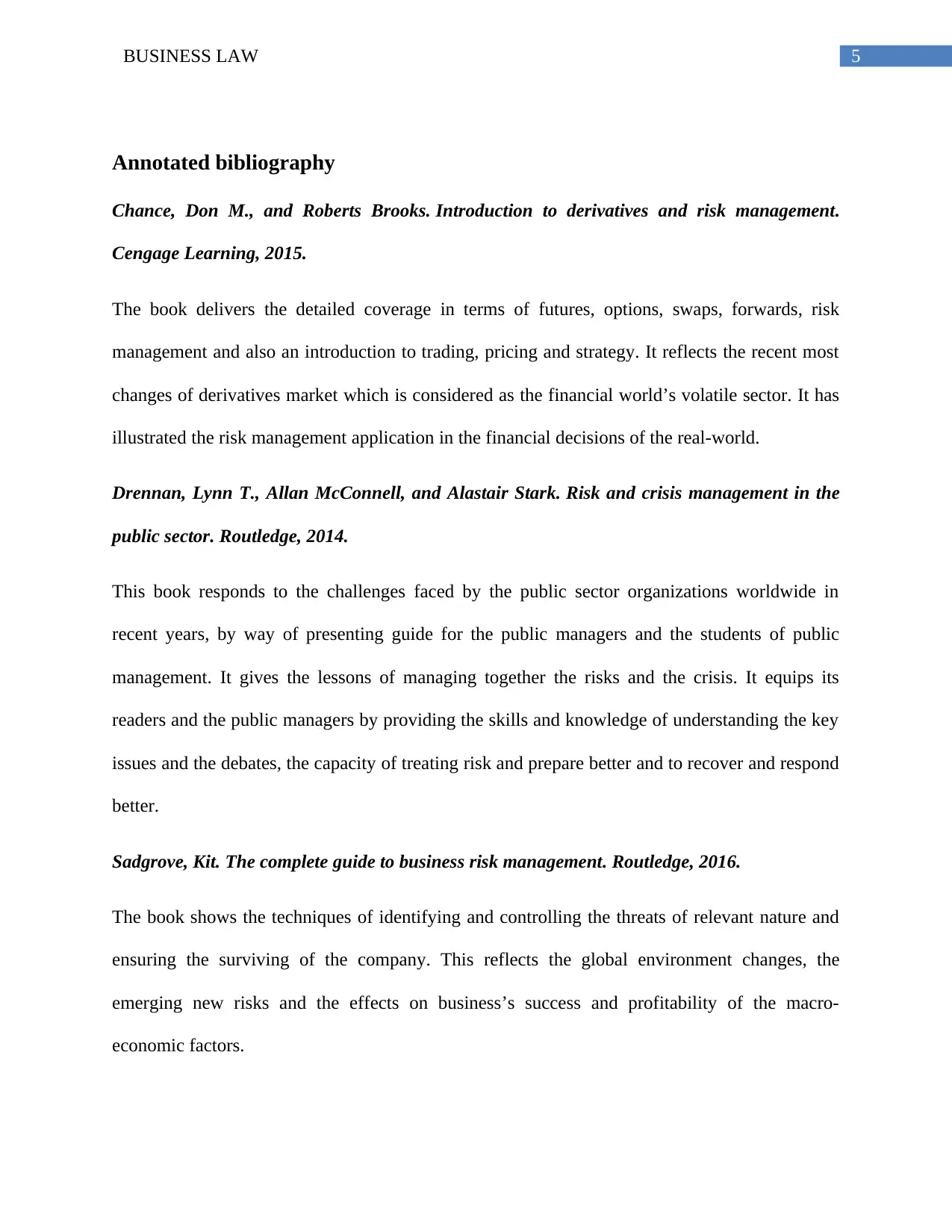
5BUSINESS LAW
Annotated bibliography
Chance, Don M., and Roberts Brooks. Introduction to derivatives and risk management.
Cengage Learning, 2015.
The book delivers the detailed coverage in terms of futures, options, swaps, forwards, risk
management and also an introduction to trading, pricing and strategy. It reflects the recent most
changes of derivatives market which is considered as the financial world’s volatile sector. It has
illustrated the risk management application in the financial decisions of the real-world.
Drennan, Lynn T., Allan McConnell, and Alastair Stark. Risk and crisis management in the
public sector. Routledge, 2014.
This book responds to the challenges faced by the public sector organizations worldwide in
recent years, by way of presenting guide for the public managers and the students of public
management. It gives the lessons of managing together the risks and the crisis. It equips its
readers and the public managers by providing the skills and knowledge of understanding the key
issues and the debates, the capacity of treating risk and prepare better and to recover and respond
better.
Sadgrove, Kit. The complete guide to business risk management. Routledge, 2016.
The book shows the techniques of identifying and controlling the threats of relevant nature and
ensuring the surviving of the company. This reflects the global environment changes, the
emerging new risks and the effects on business’s success and profitability of the macro-
economic factors.
Annotated bibliography
Chance, Don M., and Roberts Brooks. Introduction to derivatives and risk management.
Cengage Learning, 2015.
The book delivers the detailed coverage in terms of futures, options, swaps, forwards, risk
management and also an introduction to trading, pricing and strategy. It reflects the recent most
changes of derivatives market which is considered as the financial world’s volatile sector. It has
illustrated the risk management application in the financial decisions of the real-world.
Drennan, Lynn T., Allan McConnell, and Alastair Stark. Risk and crisis management in the
public sector. Routledge, 2014.
This book responds to the challenges faced by the public sector organizations worldwide in
recent years, by way of presenting guide for the public managers and the students of public
management. It gives the lessons of managing together the risks and the crisis. It equips its
readers and the public managers by providing the skills and knowledge of understanding the key
issues and the debates, the capacity of treating risk and prepare better and to recover and respond
better.
Sadgrove, Kit. The complete guide to business risk management. Routledge, 2016.
The book shows the techniques of identifying and controlling the threats of relevant nature and
ensuring the surviving of the company. This reflects the global environment changes, the
emerging new risks and the effects on business’s success and profitability of the macro-
economic factors.
⊘ This is a preview!⊘
Do you want full access?
Subscribe today to unlock all pages.

Trusted by 1+ million students worldwide
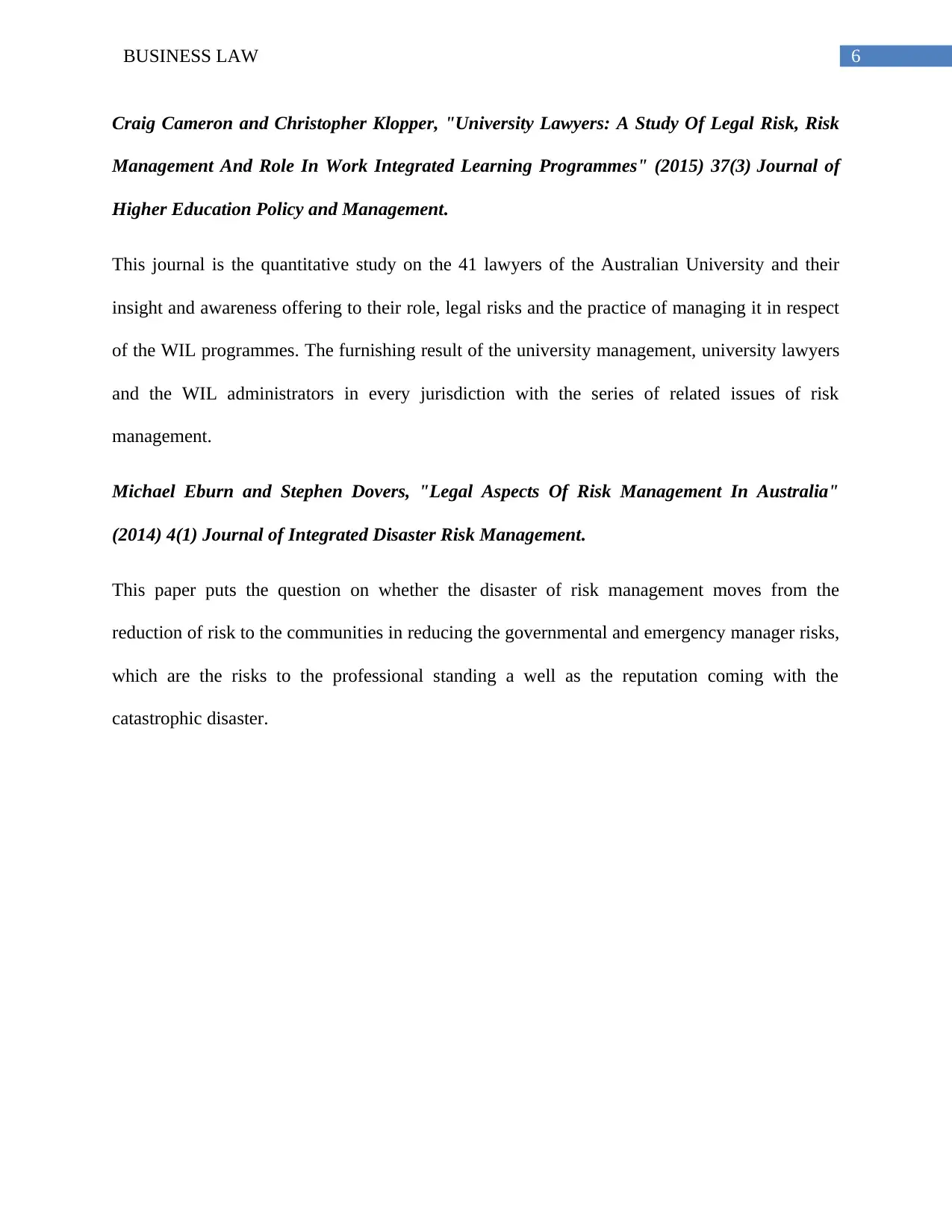
6BUSINESS LAW
Craig Cameron and Christopher Klopper, "University Lawyers: A Study Of Legal Risk, Risk
Management And Role In Work Integrated Learning Programmes" (2015) 37(3) Journal of
Higher Education Policy and Management.
This journal is the quantitative study on the 41 lawyers of the Australian University and their
insight and awareness offering to their role, legal risks and the practice of managing it in respect
of the WIL programmes. The furnishing result of the university management, university lawyers
and the WIL administrators in every jurisdiction with the series of related issues of risk
management.
Michael Eburn and Stephen Dovers, "Legal Aspects Of Risk Management In Australia"
(2014) 4(1) Journal of Integrated Disaster Risk Management.
This paper puts the question on whether the disaster of risk management moves from the
reduction of risk to the communities in reducing the governmental and emergency manager risks,
which are the risks to the professional standing a well as the reputation coming with the
catastrophic disaster.
Craig Cameron and Christopher Klopper, "University Lawyers: A Study Of Legal Risk, Risk
Management And Role In Work Integrated Learning Programmes" (2015) 37(3) Journal of
Higher Education Policy and Management.
This journal is the quantitative study on the 41 lawyers of the Australian University and their
insight and awareness offering to their role, legal risks and the practice of managing it in respect
of the WIL programmes. The furnishing result of the university management, university lawyers
and the WIL administrators in every jurisdiction with the series of related issues of risk
management.
Michael Eburn and Stephen Dovers, "Legal Aspects Of Risk Management In Australia"
(2014) 4(1) Journal of Integrated Disaster Risk Management.
This paper puts the question on whether the disaster of risk management moves from the
reduction of risk to the communities in reducing the governmental and emergency manager risks,
which are the risks to the professional standing a well as the reputation coming with the
catastrophic disaster.
Paraphrase This Document
Need a fresh take? Get an instant paraphrase of this document with our AI Paraphraser
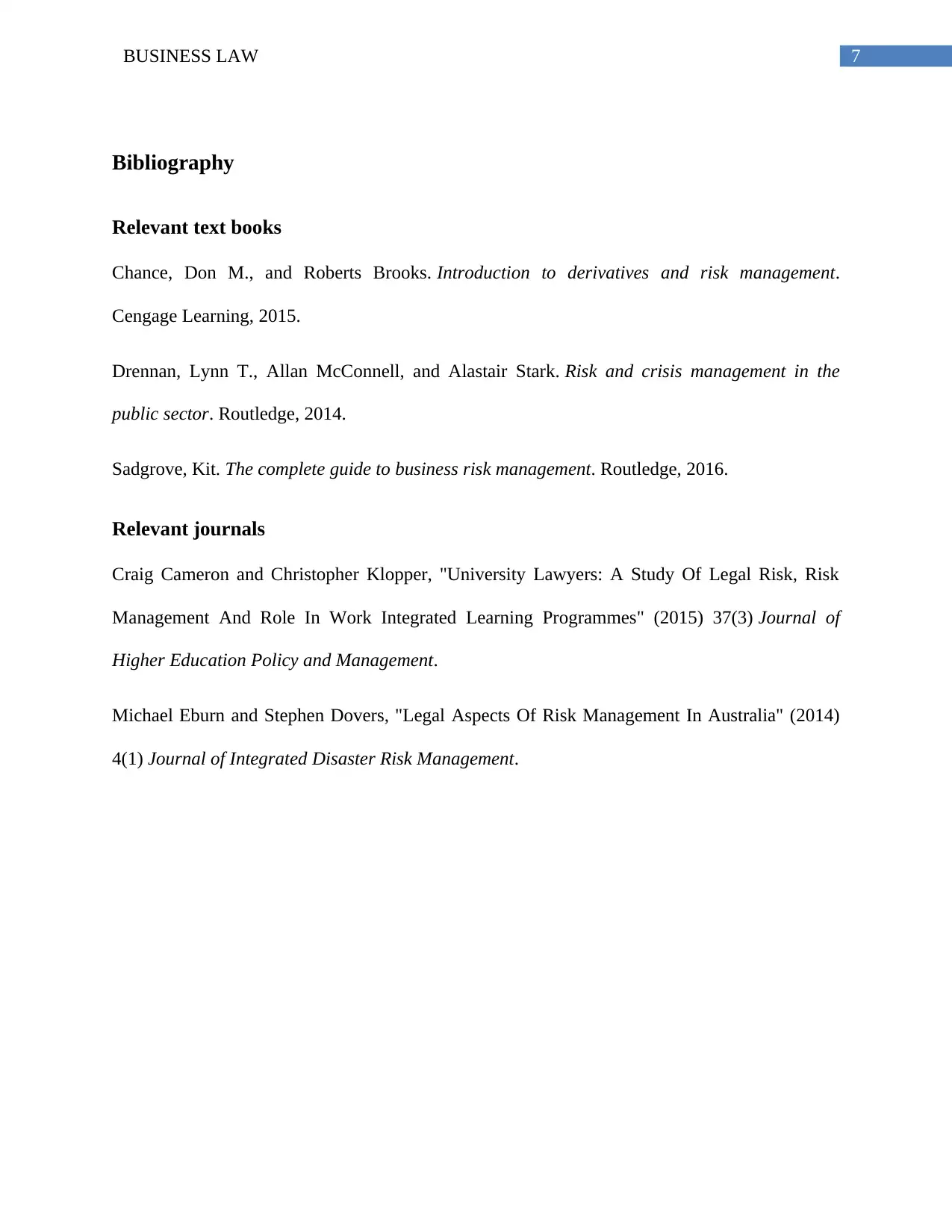
7BUSINESS LAW
Bibliography
Relevant text books
Chance, Don M., and Roberts Brooks. Introduction to derivatives and risk management.
Cengage Learning, 2015.
Drennan, Lynn T., Allan McConnell, and Alastair Stark. Risk and crisis management in the
public sector. Routledge, 2014.
Sadgrove, Kit. The complete guide to business risk management. Routledge, 2016.
Relevant journals
Craig Cameron and Christopher Klopper, "University Lawyers: A Study Of Legal Risk, Risk
Management And Role In Work Integrated Learning Programmes" (2015) 37(3) Journal of
Higher Education Policy and Management.
Michael Eburn and Stephen Dovers, "Legal Aspects Of Risk Management In Australia" (2014)
4(1) Journal of Integrated Disaster Risk Management.
Bibliography
Relevant text books
Chance, Don M., and Roberts Brooks. Introduction to derivatives and risk management.
Cengage Learning, 2015.
Drennan, Lynn T., Allan McConnell, and Alastair Stark. Risk and crisis management in the
public sector. Routledge, 2014.
Sadgrove, Kit. The complete guide to business risk management. Routledge, 2016.
Relevant journals
Craig Cameron and Christopher Klopper, "University Lawyers: A Study Of Legal Risk, Risk
Management And Role In Work Integrated Learning Programmes" (2015) 37(3) Journal of
Higher Education Policy and Management.
Michael Eburn and Stephen Dovers, "Legal Aspects Of Risk Management In Australia" (2014)
4(1) Journal of Integrated Disaster Risk Management.
1 out of 8
Related Documents
Your All-in-One AI-Powered Toolkit for Academic Success.
+13062052269
info@desklib.com
Available 24*7 on WhatsApp / Email
![[object Object]](/_next/static/media/star-bottom.7253800d.svg)
Unlock your academic potential
Copyright © 2020–2025 A2Z Services. All Rights Reserved. Developed and managed by ZUCOL.





